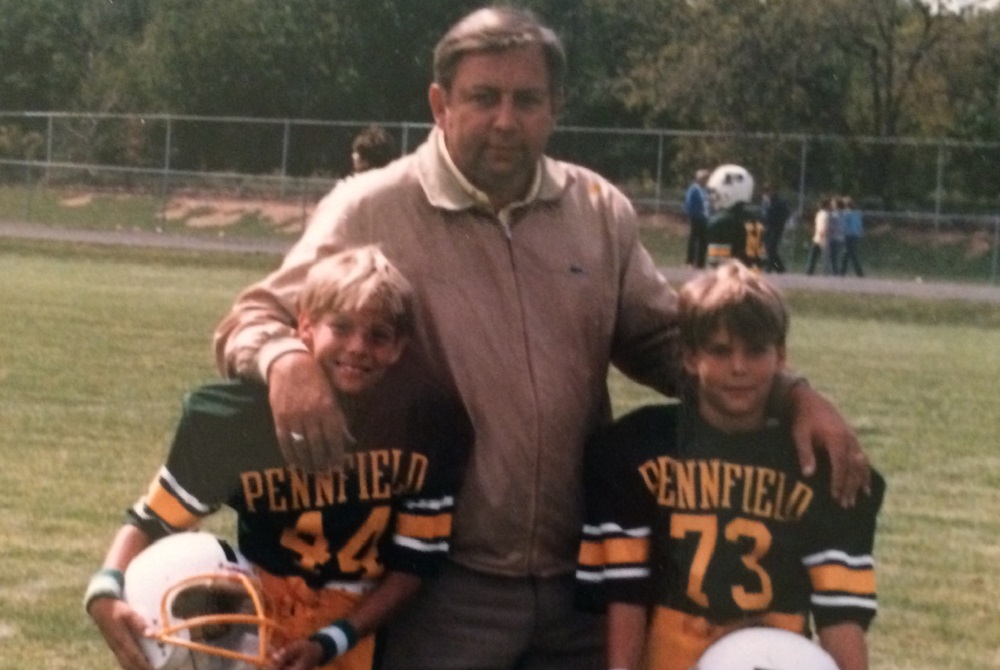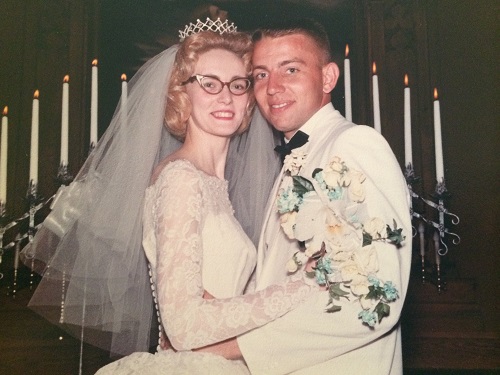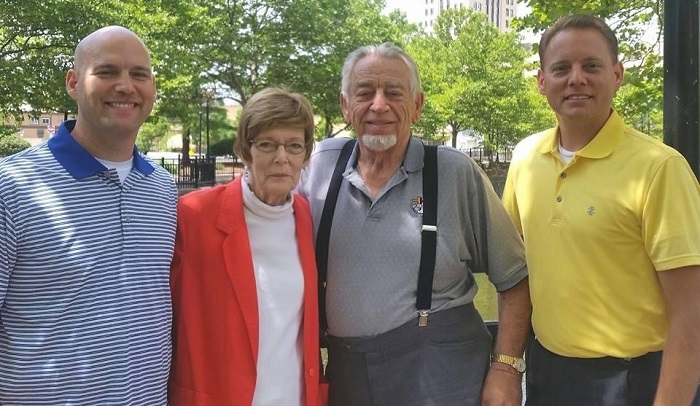
'Larger-Than-Life' Pennfield AD Admired for Statewide Service
By
Pam Shebest
Special for MHSAA.com
April 14, 2021
BATTLE CREEK — To many Battle Creek sports enthusiasts, Bernie Larson was known as “Mr. Pennfield.”
 But for two former athletes, twins Chris and Cam Larson, that was not the case.
But for two former athletes, twins Chris and Cam Larson, that was not the case.
“I never knew him or thought of him as Mr. Pennfield; he was Dad,” Chris said.
Larson, 78, who served as athletic director at Pennfield for 29 years, died March 14 after an extended illness.
A memorial service is being planned for May 15 at a time and place to be determined.
“A lot more remembrances come back when someone passes,” said Chris Larson, who lives in Virginia. “You hear so many stories from people who remember him, including former students and coaches.
“It’s great to hear the impact he had on so many people that you never knew about.”
Stories are plentiful when it comes to Bernie Larson.
“He was a heckuva golfer,” said Karen Leinaar, the current executive director of the Michigan Interscholastic Athletic Administrators Association (MIAAA) who during an early stop served as athletic director at Delton Kellogg, which with Pennfield for a time was part of the Kalamazoo Valley Association. “If you needed golf balls on the course, everyone said, ‘Just ask Bernie.’ He always had them.”
The reason?
“If he had one ball in his bag, he had 50 or 60 in his bag,” said Larry Wegener, former Battle Creek Central athletic director. “He had milk crates full of golf balls in his garage” that he found on the course or fished out of ponds.
Championship City
When Larson was named Pennfield’s athletic director in 1970, it became a family affair.
“I had no clue, no clue,” said Joni, Larson’s wife of 56 years. “We never trained to be wives of athletic directors. We learned the most from other wives.”
 She became involved in the job, selling tickets at home games. When their sons were old enough, they helped out with the field.
She became involved in the job, selling tickets at home games. When their sons were old enough, they helped out with the field.
“They knew where the flag was kept and how to play the national anthem. They learned how to keep score” and were active in playing sports, she recalled.
“Cam (who lives in Minnesota) played football, baseball and basketball,” Chris Larson said. “I played tennis, golf and basketball. We grew up playing little league baseball and football.”
One family favorite was the yearly athletic directors conference at Grand Traverse Resort.
“He was there for business; we kids were there for fun,” his son said. “As we got older, we went to the auditorium that was filled with booths with sports-related things.
“As a kid we went around and grabbed the swag. It was a kids of athletic directors thing.”
It was not all fun and games.
“Bernie Larson was instrumental putting Battle Creek on the map athletically,” Leinaar said. “Four of (the ADs), Bernie, Ralph Kenyon of Harper Creek, Glen Schulz of Lakeview and Larry Wegener of Central put on the tournaments and had crews of people every year right there helping.
“Their hard work and commitment to the MHSAA, running perfect tournaments, made Battle Creek a stop for athletics for many, many years. Many times, Bernie led the pack.”
In spite of his willingness to help others, there was a caveat, Leinaar said.
“He would say to me, ‘Karen, I’ll help you out however I can, but remember, Pennfield is going to win.’
“Pennfield joined the KVA in the late 1980s, so we saw each other quite a bit. Our football games were always barn burners as were track and field.”
 Wegener recalls those days full of tournaments and 65-hour work weeks.
Wegener recalls those days full of tournaments and 65-hour work weeks.
“We did so many MHSAA events, I think a lot of people thought we were on the staff,” he said.
Those tournaments included more than 50 state championships in baseball and softball, team and individual wrestling, volleyball and girls basketball.
Brett Steele, Pennfield’s current AD, said Larson “was still a strong presence in the athletic department and community as a whole even after he retired.
“Up until last winter, Bernie still helped out at football and basketball games as our officials host. He knew most of the officials in those sports and was a familiar face to many when they worked games at Pennfield.”
Larson had served as an MHSAA basketball and baseball official. He also helped found and is a member of the Pennfield Hall of Fame and coached both girls and boys golf.
He received the MHSAA’s Allen W. Bush Award in 1997, the MHSAA’s Charles Forsythe Award in 1999 and was the MIAAA State Athletic Director of the Year for 1991-92.
All About Family
In spite of the hours spent with his job, Larson was a good family man, Wegener said.
“He spoke highly of his kids,” he said. “Chris and Cam were the pride of his life. Joni was a real good fit for him.”
Wegener said Larson was a larger-than-life guy.
“If you were going to run a tournament and you brought a notebook full of stuff for your tournament, Bernie brought a briefcase.
“If you brought a briefcase, Bernie brought a suitcase. He just believed in being prepared for everything.”
One thing the athletic directors did a lot was frequent restaurants, and Larson had his favorites.
“Perkins whenever he traveled, the Pancake House every Sunday and the Irish Pub,” Chris Larson said.
A person could always spot Larson. He was with one with the napkin tucked over his shirt.
“He always wore a suit and tie and would use a napkin as a bib because he was always spilling something on his necktie,” Joni Larson said.
Another thing her husband was famous for was his jokes.
“He always had a favorite joke that I’d hear 27 times,” she said, laughing. “It was like he had a joke of the week, and everybody had to hear it.”
During summers, Larson taught driver’s education at the school, something Chris Larson remembers well.
 “I remember on the last day of driver’s ed, you drove for 45 minutes,” he said. “My brother and I and one other kid were in the car, and I drove to Lansing to the MHSAA and we sat in the parking lot while my dad went inside.
“I remember on the last day of driver’s ed, you drove for 45 minutes,” he said. “My brother and I and one other kid were in the car, and I drove to Lansing to the MHSAA and we sat in the parking lot while my dad went inside.
“I know the MHSAA through his eyes and through my own eyes.”
Larson’s love of sports transferred to his sons.
“We all share a love of golf and would play together any chance we got, but over the past years his health wouldn't allow him to play,” Chris Larson said. “I miss that very much.”
Another tradition is being carried on by his son, but it evolved in an unusual way.
The twins were a Christmas surprise for Bernie and Joni.
“They didn’t do ultrasounds routinely back then (1974) so we didn’t know,” Joni Larson said. “We had Bernie’s middle name, Leon, picked out as a first name,” Joni Larson said.
“When we found out there were twins, we gave Chris ‘Leon’ as his middle name and Cameron ‘Noel’ which is Leon backwards, so both had dad’s middle name.”
Chris Larson has continued the tradition, giving his oldest son, Joshua, Leon as a middle name.
Chris Larson echoed the thoughts of many who knew Mr. Pennfield as a people person.
“In my opinion, he was the most Christian man I knew. He lived a Christian life and he shared it with others,” Chris said.
“He was chaplain for some baseball and basketball teams. He knew somebody everywhere no matter where we went in the state.”
Chris Larson paid a special tribute to his father after the funeral.
“He had a parking spot in the circle of the old Pennfield High School right in front of his office,” he said. “His van was there all the time.
“One of the things I did after the funeral was just hang out there for a while.”
 Pam Shebest served as a sportswriter at the Kalamazoo Gazette from 1985-2009 after 11 years part-time with the Gazette while teaching French and English at White Pigeon High School. She can be reached at [email protected] with story ideas for Calhoun, Kalamazoo and Van Buren counties.
Pam Shebest served as a sportswriter at the Kalamazoo Gazette from 1985-2009 after 11 years part-time with the Gazette while teaching French and English at White Pigeon High School. She can be reached at [email protected] with story ideas for Calhoun, Kalamazoo and Van Buren counties.
PHOTOS: (Top) Longtime Pennfield athletic director Bernie Larson also raised his family in the district, with sons Chris (left) and Cam among those to wear the uniform. (2) Bernie and Joni Larson were married 56 years. (3) Among Larson’s longtime colleagues were former Delton Kellogg athletic director Karen Leinaar and retired Battle Creek Central athletic director Larry Wegener. (4) The Larson family, more recently, from left: Cam, Joni, Bernie and Chris. (Family photos courtesy of the Larson family; head shots by Pam Shebest.)

Flynn, Guzzo & Thayer Named 2021 Bush Award Recipients
By
Geoff Kimmerly
MHSAA.com senior editor
November 18, 2021
Birmingham Groves’ Thomas Flynn, St. Joseph’s Kevin Guzzo and Bay City Western’s Michael Thayer are leaders of Michigan high school athletic programs who have put education and providing a positive student experience at the forefront of their work, while also becoming known among colleagues for their guidance and assistance to others striving to build the same foundations at their schools.
To recognize not only their work within their districts but their impacts on many other leaders in athletic administration, Flynn, Guzzo and Thayer have been named recipients of the Michigan High School Athletic Association’s Allen W. Bush Award for 2021.
Al Bush served as executive director of the MHSAA for 10 years. The award honors individuals for past and continuing service to school athletics as a coach, administrator, official, trainer, doctor or member of the media. The award was developed to bring recognition to people who are giving and serving without a lot of attention. This is the 30th year of the award, with selections made by the MHSAA's Representative Council.
 Flynn has begun his 21st year as Birmingham Groves High School athletic director and 32nd overall at the school after beginning as a teacher. He has served as a host of MHSAA Tournament events in team and individual wrestling, girls and boys diving, girls and boys tennis, girls and boys basketball, baseball and softball, football, ice hockey, volleyball and girls and boys soccer. Flynn also has served on MHSAA Committees for wrestling, gymnastics, swimming & diving, tennis and various officials topics. He made Groves the home of all Metro Detroit Officials Association meetings and has received recognition for his service to the Oakland County Wrestling Officials Association.
Flynn has begun his 21st year as Birmingham Groves High School athletic director and 32nd overall at the school after beginning as a teacher. He has served as a host of MHSAA Tournament events in team and individual wrestling, girls and boys diving, girls and boys tennis, girls and boys basketball, baseball and softball, football, ice hockey, volleyball and girls and boys soccer. Flynn also has served on MHSAA Committees for wrestling, gymnastics, swimming & diving, tennis and various officials topics. He made Groves the home of all Metro Detroit Officials Association meetings and has received recognition for his service to the Oakland County Wrestling Officials Association.
Flynn has served as president, vice president, secretary and treasurer for the Oakland County Athletic Directors Association, and as the Region 11 representative for the Michigan Interscholastic Athletic Administrators Association (MIAAA). A certified athletic trainer, he also is a longtime member of the National Athletic Trainers Association. The MIAAA named Flynn a Regional Athletic Director of the Year in 2012.
He graduated from Hillsdale High School in 1984, then earned a bachelor’s degree in biology with an emphasis on sports medicine from Grand Valley State University in 1990. He received a master’s in sports administration from Wayne State University. Flynn also has served on the Birmingham Bloomfield Community Coalition.
“Tom is a guy who is willing to do anything to assist the MHSAA. He’s hosted an Individual Wrestling District for 20-plus years, and that’s far-and-away the most difficult event to host – and he wants to do it every year,” MHSAA Executive Director Mark Uyl said. “Tom is not afraid to do the dirty work, but he’s also not afraid to speak up, and that’s something I’ve always admired and appreciated about him.”
 Guzzo has begun his 26th year with St. Joseph Public Schools and 18th as athletic director after previously serving as a coach and teacher. He earned his elite certification in the MHSAA Coaches Advancement Program in 2014 and has served as a CAP instructor and as an instructor for the National Interscholastic Athletic Administrators Association (NIAAA) Leadership Training Institute. He also has served as chairperson representing the MIAAA on the Five State Exchange Committee. A frequent contributor as well to MHSAA Committees for sports, officials, classification and site selection, Guzzo recently contributed as part of the MHSAA Multi-Sport Task Force.
Guzzo has begun his 26th year with St. Joseph Public Schools and 18th as athletic director after previously serving as a coach and teacher. He earned his elite certification in the MHSAA Coaches Advancement Program in 2014 and has served as a CAP instructor and as an instructor for the National Interscholastic Athletic Administrators Association (NIAAA) Leadership Training Institute. He also has served as chairperson representing the MIAAA on the Five State Exchange Committee. A frequent contributor as well to MHSAA Committees for sports, officials, classification and site selection, Guzzo recently contributed as part of the MHSAA Multi-Sport Task Force.
He received his certified athletic administrator (CAA) designation from the NIAAA in 2007 and was named an MIAAA Regional Athletic Director of the Year in 2015.
Guzzo graduated from Bessemer High School in 1991, then earned his bachelor’s degree in secondary mathematics at Western Michigan University in 1995 and master’s in math education from WMU in 2001. He has been active in the St. Joseph Lions Club, First Tee of Benton Harbor and the local Senior PGA Tournament Committee.
“Kevin has become a real leader in the southwestern corner of the state, and in many rooms has grown into a veteran voice of reason on many topics and issues,” Uyl said. “He’s taken what he’s learned over the years and incorporated it into his teaching as a Coaches Advancement Program instructor, and we are thrilled that we have many beginning coaches who one of their first mentors is a person like Kevin through CAP.”
 Thayer has begun his 25th year as an athletic director and also serves as an assistant principal at Western. He served at Merrill Community Schools from 1995-2007 before arriving at Western with the start of the 2007-08 school year. He also is a frequent MHSAA Tournament host and has been a valued voice on a variety of MHSAA Committees, including the Multi-Sport Task Force and selection committee for the MHSAA-Farm Bureau Insurance Scholar-Athlete Awards. Additionally, he has served as the MIAAA’s historical records chairperson and as part of its public relations committee.
Thayer has begun his 25th year as an athletic director and also serves as an assistant principal at Western. He served at Merrill Community Schools from 1995-2007 before arriving at Western with the start of the 2007-08 school year. He also is a frequent MHSAA Tournament host and has been a valued voice on a variety of MHSAA Committees, including the Multi-Sport Task Force and selection committee for the MHSAA-Farm Bureau Insurance Scholar-Athlete Awards. Additionally, he has served as the MIAAA’s historical records chairperson and as part of its public relations committee.
He is active with the NIAAA and Michigan Association of Secondary School Principals (MASSP) and National Association of Secondary School Principals (NASSP). He was selected for a Regional Athletic Director of the Year Award by the MIAAA in 2017, and also that year received the MIAAA’s George Lovich State Award of Merit.
Thayer graduated from Muskegon Orchard View High School in 1986, then earned his bachelor’s degree in business teaching from Central Michigan University in 1990 and master’s in educational administration/school principalship from CMU in 2003. He also is a CAP elite-certification graduate. He has served as a trustee for Thomas Township – with membership in the Michigan Township Association – and been active in the Shields Lions Club.
“Mike has been one of the true leaders of the Saginaw Valley League for a long time, and he’s really become the point guard of that league over the last five years,” Uyl said. “If ever someone should be defined for quiet, steady leadership, it’s Mike Thayer. It’s always about substance with Mike. He’s as reliable an athletic director as there is in the country.”

